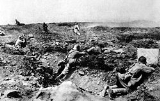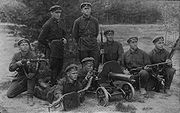
Second generation warfare
Encyclopedia

Military of the United States
The United States Armed Forces are the military forces of the United States. They consist of the Army, Navy, Marine Corps, Air Force, and Coast Guard.The United States has a strong tradition of civilian control of the military...
in 1989, referring to the tactics of warfare used after the invention of the rifled musket
Rifled musket
The term rifled musket or rifle musket refers to a specific type of weapon made in the mid-19th century. Originally the term referred only to muskets that had been produced as a smoothbore weapon and later had their barrels rifled...
and breech-loading weapon
Breech-loading weapon
A breech-loading weapon is a firearm in which the cartridge or shell is inserted or loaded into a chamber integral to the rear portion of a barrel....
s and continuing through the development of the machine gun
Machine gun
A machine gun is a fully automatic mounted or portable firearm, usually designed to fire rounds in quick succession from an ammunition belt or large-capacity magazine, typically at a rate of several hundred rounds per minute....
and indirect fire
Indirect fire
Indirect fire means aiming and firing a projectile in a high trajectory without relying on a direct line of sight between the gun and its target, as in the case of direct fire...
.
History
In the 1800s, the invention of the breech-loading rifled musket meant longer range, greater accuracy, and faster rate of fire. Marching ranks of men straight into a barrage of fire from such weapons would cause tremendous rates of casualties, so a new strategy was developed.Second generation warfare still maintained lines of battle
Line of battle
In naval warfare, the line of battle is a tactic in which the ships of the fleet form a line end to end. A primitive form had been used by the Portuguese under Vasco Da Gama in 1502 near Malabar against a Muslim fleet.,Maarten Tromp used it in the Action of 18 September 1639 while its first use in...
but focused more on the use of technology to allow smaller units of men to maneuver separately. These smaller units allowed for faster advances, less concentrated casualties, and the ability to use cover and concealment to advantage.
To some degree, these concepts have remained in use even as the next generations have arisen, so the end of the second generation is not as clearly defined as that of the first. The development of the blitzkrieg
Blitzkrieg
For other uses of the word, see: Blitzkrieg Blitzkrieg is an anglicized word describing all-motorised force concentration of tanks, infantry, artillery, combat engineers and air power, concentrating overwhelming force at high speed to break through enemy lines, and, once the lines are broken,...
highlighted some of the flaws of static firing positions and slow-moving infantry, so this can be considered the beginning of the end for the second generation, at least as the dominant force in military strategy.
Contributions to warfare
The contributions of the second generation were responses to technological development. The second generation saw the rise of trench warfareTrench warfare
Trench warfare is a form of occupied fighting lines, consisting largely of trenches, in which troops are largely immune to the enemy's small arms fire and are substantially sheltered from artillery...
, artillery
Artillery
Originally applied to any group of infantry primarily armed with projectile weapons, artillery has over time become limited in meaning to refer only to those engines of war that operate by projection of munitions far beyond the range of effect of personal weapons...
support, more advanced reconnaissance
Reconnaissance
Reconnaissance is the military term for exploring beyond the area occupied by friendly forces to gain information about enemy forces or features of the environment....
techniques, extensive use of camouflage uniforms
Military camouflage
Military camouflage is one of many means of deceiving an enemy. In practice, it is the application of colour and materials to battledress and military equipment to conceal them from visual observation. The French slang word camouflage came into common English usage during World War I when the...
, radio
Radio
Radio is the transmission of signals through free space by modulation of electromagnetic waves with frequencies below those of visible light. Electromagnetic radiation travels by means of oscillating electromagnetic fields that pass through the air and the vacuum of space...
communications, and fireteam
Fireteam
A fireteam is a small military unit of infantry. It is the smallest unit in the militaries that use it and is the primary unit upon which infantry organization is based in the British Army, Royal Air Force Regiment, Royal Marines, United States Army, United States Marine Corps, United States Air...
maneuvers.
Examples
- American Civil WarAmerican Civil WarThe American Civil War was a civil war fought in the United States of America. In response to the election of Abraham Lincoln as President of the United States, 11 southern slave states declared their secession from the United States and formed the Confederate States of America ; the other 25...
- Boer WarBoer WarThe Boer Wars were two wars fought between the British Empire and the two independent Boer republics, the Oranje Vrijstaat and the Republiek van Transvaal ....
- World War IWorld War IWorld War I , which was predominantly called the World War or the Great War from its occurrence until 1939, and the First World War or World War I thereafter, was a major war centred in Europe that began on 28 July 1914 and lasted until 11 November 1918...
- Spanish Civil WarSpanish Civil WarThe Spanish Civil WarAlso known as The Crusade among Nationalists, the Fourth Carlist War among Carlists, and The Rebellion or Uprising among Republicans. was a major conflict fought in Spain from 17 July 1936 to 1 April 1939...
- World War IIWorld War IIWorld War II, or the Second World War , was a global conflict lasting from 1939 to 1945, involving most of the world's nations—including all of the great powers—eventually forming two opposing military alliances: the Allies and the Axis...
See also
- First generation warfareFirst generation warfareFirst generation warfare is a term created by the U.S. military in 1989, referring to the earliest stages of organized, state-controlled armed forces waging war in the modern era....
- Third generation warfareThird generation warfareThird generation warfare is a term created by the U.S. military in 1989, referring to the tactics of warfare used after the Wehrmacht's development of the blitzkrieg....
- Fourth generation warfareFourth generation warfareFourth generation warfare is conflict characterized by a blurring of the lines between war and politics, soldier and civilian.The term was first used in 1989 by a team of United States analysts, including William S. Lind, to describe warfare's return to a decentralized form...

